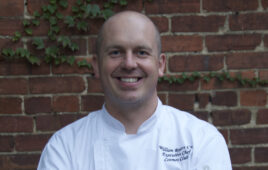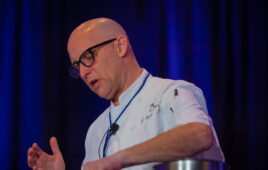
The Mexi-Asian Tacos with Smoky Cheese feature
sliced pork tenderloin, kimchi, scallions, radishes and chipotle jack cheese.
Endlessly customizable, tacos are trending.
When it comes to tacos, Daniel Defusco, Executive Chef of Hershey (Pa.) Country Club (HCC), takes a “why not” approach.
“Tacos are approachable and fun,” says Defusco, who has been with HCC for a little more than a year and a half. “You don’t really know if a flavor combination will work in a taco until you try it. With every other item on our menu, we’re intentional [and] I always ask my cooks, ‘Why?’ But with tacos, I ask, ‘Why not?’”
HCC serves tacos filled with a wide range of components, including Cuban pork, mojo chicken, South Carolina bbq, curried lamb stew and even a vegan version made with roasted sweet potatoes tossed with harissa, cumin and chickpeas.
“We currently have a vegetarian entrée taco that features quinoa and jasmine rice,” says Defusco, who changes the menus at the club every six weeks. “It’s topped with pickled red onion, a housemade chipotle grilled onion sauce, and cheese.”
Ultimately, a taco’s success hinges on three qualities: taste, texture and eatability.
“Simpler is better,” says Defusco. “Balancing all of the different flavors and textures can be tricky, especially if there are a lot of complex components.”
Jason Connelly, Senior Sous Chef at the Harbor Beach Marriott & Spa’s Sea Level Restaurant + Ocean Bar, Fort Lauderdale, Fla., agrees.
“Tacos are best when they feature quality ingredients prepared well,” says Connelly, who menus two different tacos at Sea Level. One features mahi mahi topped with pico de gallo, mango relish, queso fresco and a bright mango cilantro aioli. The other taco features chipotle rock shrimp topped with pico de gallo, mango salsa and cotija cheese. It’s garnished with crispy fried onions.
“Tacos are a fun outlet for chefs to be creative,” notes Connelly. “They also lend themselves well to beautiful plate presentations.”
That’s certainly the case at the Traditions Club in Bryan, Texas, where Executive Chef Michael Menchaca serves Shiner Bock tacos paired with a liquid nitrogen prickly pear margarita on a 4×4 cedar plank.
“We braise shredded short ribs in the beer for five hours,” says Menchaca, who prices tacos at around $10 while running an overall food cost of 38%. “Then we make homemade corn tortillas and allow members to customize the toppings.”
Members can choose between shredded lettuce, pico de gallo, queso fresco, sour cream, black bean salsa, mango salsa, onions and jalapenos.
“Members love them,” says Menchaca. “We run them as a special from time to time, and they’re always a huge hit.”
At The Clubs of Kingwood (Texas), plates aren’t part of the club’s most successful tacos, which are served in to-go containers.
In the club’s halfway house, Director of Outside Services, Claudia Salas, prepares a different taco special every day for golfers. But according to Jordan Otto, Kingwood’s Director of Food & Beverage, the tacos have developed such a fan base that members who aren’t playing golf flock to the halfway house during lunch just to eat them.
“It’s not uncommon to see members in suits walking out to the halfway house to eat one of Claudia’s tacos,” says Otto.
“Our most popular taco is the pork carnitas taco,” adds Salas, who has worked at the club for 18 years. “It’s topped with chopped onion, fresh cilantro and extra-green tomatillo sauce.”
Other popular variations include Salas’ tacos al pastor, which feature marinated pork combined with pineapple, then topped with cilantro, onion, and green or red hot sauce. Her chicharrón tacos are also a hit, made with fried pork rinds and thick, spicy green and red sauces, then topped with queso fresco, onion and cilantro.
“Tacos are a great fit for our halfway house because they are easy to eat quickly, but they still satisfy,” says Salas. “Plus, from an operational standpoint, after the preparations of all of the components are done, the time required to expedite a taco is minimal.”
The same can be said for tacos served inside the clubhouse, notes Hershey’s Defusco, who menus tacos as part of the club’s every-other-week Taco Tuesday event.
“Tacos work for banquets, in action stations and as a passed hors d’oeuvres,” he says. “They work as a small plate, as an appetizer or as an entrée. They’re a perfectly social food because they don’t force you to sit at a table and eat with a fork. They’re easy to produce a la minute—and most importantly, everyone enjoys them.”


